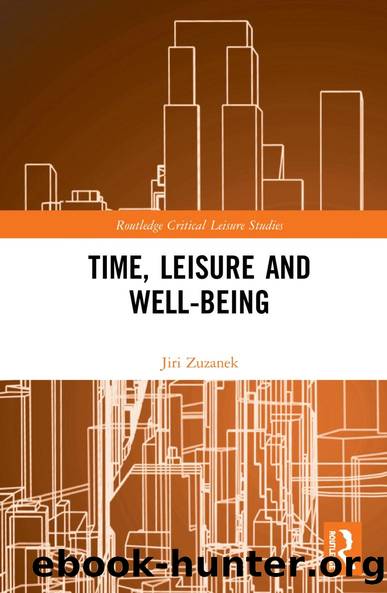Time, Leisure and Well-Being by Jiri Zuzanek

Author:Jiri Zuzanek [Zuzanek, Jiri]
Language: eng
Format: epub
Tags: Business & Economics, Time Management, Social Science, Sociology, General, Sports & Recreation
ISBN: 9781317213154
Google: HGgPEAAAQBAJ
Publisher: Routledge
Published: 2020-08-02T01:01:36+00:00
Critique of conspicuous consumption
Veblen formulated a sophisticated theory of social competitiveness. So long as a comparison of oneâs situation with the situation of others is distinctly unfavourable, Veblen argued, âthe normal, average individual will live in a chronic dissatisfaction with his present lotâ. When this individual has reached
what may be called the normal pecuniary standard of the community, or of his class in the community, this chronic dissatisfaction will give place to a restless straining to place a wider and ever-widening pecuniary interval between himself and the average standard.
(1953: 39)
It is not the propensity to save or truck and barter that animates the man in the modern world, but the propensity to excel his neighbour.
The desire for wealth, according to Veblen, can never be satiated. If the incentive to accumulate would be based on the want of subsistence or physical comfort, then the aggregate economic wants of the community could conceivably be satisfied at some point by advances of industrial efficiency, âbut since the struggle is substantially a race for reputability, no definite attainment is possibleâ (1953: 39). As fast as a person makes new acquisitions and becomes accustomed to the resulting standard, this new standard ceases to afford appreciably greater satisfaction than the earlier one. According to Veblen, we are dealing with an ever-expanding circle of consumption aspirations and acquisitions of new items, some of which serve utilitarian purposes but most are just partly or completely useless status symbols. Conspicuously wasteful honorific expenditures, Veblen insists, are often perceived as more indispensable than expenditures administered to the âlowerâ wants of physical well-being or sustenance (1953: 81).
Veblenâs violent condemnation of virtually all consumption, save the subsistence one, did not endear him to most economists. They were not prepared to accept Veblenâs distinction between the âserviceableâ (legitimate) and ânon-serviceableâ (wasteful) needs. As observed ironically by David Riesman (1953), if one were to read Veblen literally, it would seem that he wanted men to live by bread alone, âprovided Consumersâ Research had studied the ingredientsâ and no middleman had made a profit of the loaf.
It is not easy to distinguish between legitimate and conspicuous (wasteful) needs or aspirations. Things which seem wasteful at first are often incorporated into âdecent consumptionâ and become badly needed. Veblen appeared sometimes as a moralist rather than a critical analyst. And, yet, there was something in his critique that resonated with the feelings of his contemporaries and continues to resonate with us. Veblen, who was, according to Mills, an âunfashionable mindâ, established a fashion of critical thinking, which applies to the middle-class America of the 1930s and the âmass societyâ of the Post-World War II era no less than to the America of the late 19th century. âAs a criticâ, Mills wrote, âVeblen was effective precisely because he used the American value of efficiency to criticize American reality. He merely took this value seriously and used it with devastatingly systemic rigourâ (C. W. Mills, in TLC, xi).
Download
This site does not store any files on its server. We only index and link to content provided by other sites. Please contact the content providers to delete copyright contents if any and email us, we'll remove relevant links or contents immediately.
Tools of Titans by Timothy Ferriss(8157)
Change Your Questions, Change Your Life by Marilee Adams(7566)
Deep Work by Cal Newport(6818)
Man-made Catastrophes and Risk Information Concealment by Dmitry Chernov & Didier Sornette(5878)
Playing to Win_ How Strategy Really Works by A.G. Lafley & Roger L. Martin(5774)
Digital Minimalism by Cal Newport;(5588)
Big Magic: Creative Living Beyond Fear by Elizabeth Gilbert(5556)
The Slight Edge by Jeff Olson(5315)
Ego Is the Enemy by Ryan Holiday(5228)
The Motivation Myth by Jeff Haden(5125)
Stone's Rules by Roger Stone(4989)
The Laws of Human Nature by Robert Greene(4926)
Tuesdays with Morrie by Mitch Albom(4600)
Eat That Frog! by Brian Tracy(4385)
Rising Strong by Brene Brown(4341)
Skin in the Game by Nassim Nicholas Taleb(4123)
The Money Culture by Michael Lewis(4027)
Bullshit Jobs by David Graeber(3994)
Skin in the Game: Hidden Asymmetries in Daily Life by Nassim Nicholas Taleb(3868)
